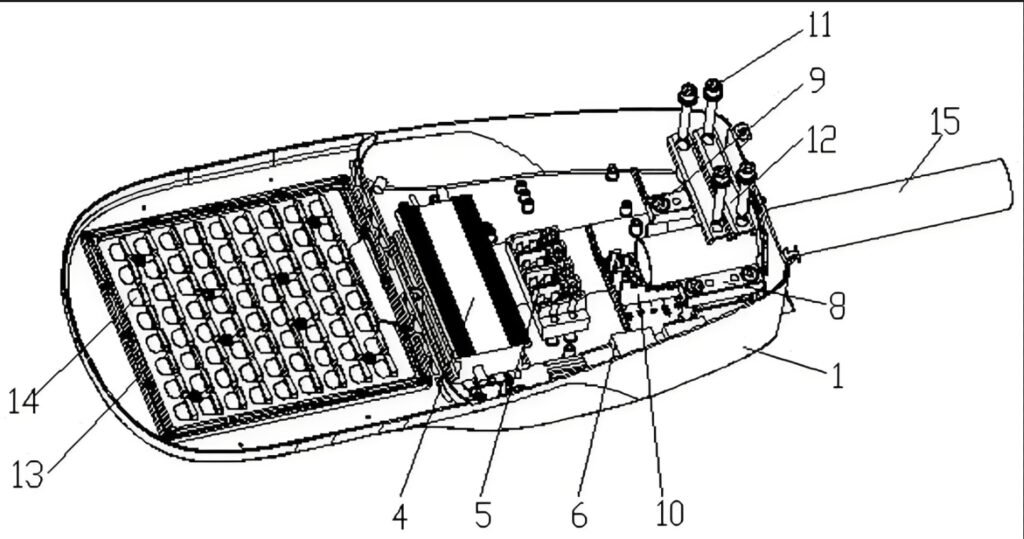1. Introduction
As global demand for LED street lighting continues to rise, many businesses are looking for cost-effective ways to import these products. One effective strategy is importing LED street light SKD (Semi-Knocked Down) kits, which helps reduce costs, improve customization, and streamline local assembly.
In this guide, we will cover everything you need to know about LED street light SKD imports, including tax benefits, cost savings, logistics, and quality control strategies.
For more insights on LED street light procurement, check out How to Find the Best Streetlight Suppliers in China.

2. What Does SKD Stand for in Import?
What is SKD in Importing?
SKD (Semi-Knocked Down) refers to products that are shipped in partially assembled components, allowing the final assembly to be completed in the destination country. This method is commonly used to reduce import duties, improve logistics efficiency, and support local assembly industries.
What is SKD in LED Lighting?
In the LED lighting industry, SKD refers to LED street lights and other lighting products shipped as semi-assembled kits, including:
- LED modules
- Light housing and heat sinks
- Drivers and power supplies
- Mounting brackets and poles
Businesses can import these components separately and assemble them locally to meet market-specific requirements.
For a comprehensive understanding of SKD in LED lighting, refer to The Ultimate Guide to Street Light Certifications and Standards.

3. How Importing LED Street Light SKD Helps Reduce Taxes
Tax Reduction Benefits of SKD Imports
Many countries impose high import tariffs on fully assembled LED street lights but offer reduced tax rates on SKD components.
For example:
- India: Fully assembled LED lights face higher customs duties, while SKD kits qualify for lower tariffs.
- Brazil: LED street light components imported separately can be taxed at a lower rate.
- Philippines & Indonesia: Governments encourage local assembly, making SKD imports more cost-effective.
For more details on SKD tax benefits, visit Why Are LED Streetlights Replacing Traditional Lights?.
How to Leverage Tax Benefits?
- Check your country’s import duty structures for assembled LED street lights vs. SKD kits.
- Work with customs brokers to optimize duty classifications.
- Split shipments strategically to maximize tax savings (discussed in logistics section).
4. Lower Initial Investment: Ideal for New Businesses
For SMEs and startups, importing SKD LED street lights provides:
1. Reduced Upfront Costs
- SKD kits cost less than fully assembled products.
- Businesses can purchase in smaller batches to avoid high capital investment.
2. Lower Warehousing and Storage Costs
- Components are easier to store and transport than bulky assembled street lights.
- Flexible inventory management allows businesses to scale gradually.
3. Greater Customization Opportunities
- Buyers can choose different drivers, LEDs, and controls to meet regional specifications.
- Enables easy upgrades and smart lighting integration.
For more on how SKD imports lower costs, check out How to Buy the Light from MVS Lighting.
5. Customizing and Branding with Neutral Packaging
Many businesses prefer neutral packaging when importing SKD LED street lights for the following reasons:
1. Easier Branding and Local Distribution
- Neutral packaging allows custom labeling and brand positioning.
- Distributors can avoid factory logos and market the product as their own.
2. Simplifies Compliance with Local Regulations
- Some countries require specific product labeling, branding, and packaging rules.
- Importers can customize manuals, stickers, and warranty details.
For more details on street light customization, refer to Which Type of Streetlight is Suitable for Highways?.
6. Enhancing Marketability with Bilingual Labels and Manuals
Why Use Bilingual Labels?
- Improves product understanding for local customers.
- Reduces complaints and return rates due to misinterpretation of instructions.
- Meets regulatory labeling requirements in certain regions.
Recommended Language Combinations
| Region | Recommended Labeling Language |
|---|---|
| Middle East | Arabic + English |
| South America | Spanish/Portuguese + English |
| Southeast Asia | Thai/Indonesian/Vietnamese + English |
| Europe | French/German/Russian + English |
For more on LED street light customization, check out How to Choose the Right Wattage for Your Streetlights.
7. Logistics & Quality Control Tips for SKD Imports
Choosing the Right Shipping Method
| Shipping Mode | Pros | Cons |
|---|---|---|
| Sea Freight | Cost-effective for bulk orders | Long lead time |
| Air Freight | Fast shipping | Expensive |
| Rail Freight | Balanced cost and speed | Limited routes |
Ensuring Quality During Transit
- Request QC reports before shipment.
- Ensure components are well-packaged (foam protection, separated boxes).
- Use shock-proof packaging to prevent damage to LED chips and drivers.
For more tips on shipping and logistics, visit How to Install Outdoor Lighting: Step-by-Step Guide.
Smart Shipping Strategy: Splitting SKD Shipments to Reduce Taxes
A smart way to optimize tax savings is shipping LED fixtures and drivers separately:
- Batch 1: Ship LED fixtures without drivers.
- Batch 2: Send drivers in a separate shipment.
Why?
- Some countries tax fully assembled LED lights higher than individual components.
- Importing in separate shipments reduces customs duties.
- Improves cash flow and inventory control.
For more on tax-efficient logistics, refer to How Surge Protection Ensures Reliable Performance of Street Lighting Systems.
8. Conclusion
Importing LED street light SKD kits provides:
✔ Lower import duties by shipping semi-assembled components.
✔ Lower investment risks for startups and SMEs.
✔ More branding and customization opportunities.
✔ Flexible logistics options for reducing costs.
For further information on finding reliable LED street light suppliers, visit Where to Source the Best Outdoor Lighting Suppliers.
🚀 If you’re looking for the best LED street light SKD solutions, contact us today at MVS Lighting!

